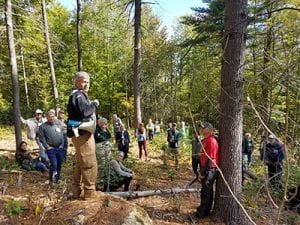TACF’s Annual Meeting in South Portland, Maine began on Thursday evening, October 5 with a traditional lobster bake on Peak’s Island and ended with a Saturday inland Maine chestnut restoration tour; hues of red, orange and yellow fall foliage as a backdrop. Led by Dr. Brian Roth, ME-TACF Science Chair and Acting Director of the Cooperative Forestry Research Unit at the University of Maine’s School of Forest Resources, the tour included stops in Vienna, pronounced Vi (rhymes with eye)-n-a (a as in applause), Readfield, and Winthrop

Ron Lemin with Crop Production Services, leads a talk about the importance of controlling associated vegetation in a restoration trial in Vienna, ME.
The Vienna stop was at a Maine Woodlot Owners Trust property donated by Chester Ladd: a recently harvested shelterwood about an acre in size. The goal of the chestnut plantings here, one of two locations, is to study cold adaptation—Maine winters are cold!—and blight resistance in a forested setting. Consultant Ron Lemin discussed how the site had been prepared to make room for the seedlings to grow, while remaining protected from cold by the overstory canopy. Seeds were selected from contrasting temperature zones, grown in greenhouses, and planted with aluminum flashing for protection in a mixed family block design. Tom Saielli, TACF Mid-Atlantic Regional Science Coordinator, described results from a similar older trial in Vermont. Outcomes from these restoration trials will inform future chestnut forest reintroduction at the northern edge of the range.
Our second stop was in the town of Readfield where we were warmly greeted at the town hall by Dale Clark, a member of the local historical society. Readfield emerged toward the end of the eighteenth century once the land up and down the Kennebec River near Augusta had become completely privatized. West of the town, land was cheap and available and advertised as such. Adjacent to Maranacook Lake, Readfield became a vibrant nineteenth century industrial town that included woolen, saw, and bark mills, a carriage shop and grist mill, as well as a tannery and a cordwainer’s (shoemaker’s) shop. In addition, while its population has never been more than some 2,600 residents, Readfield has been the hometown to three Maine governors.

Tour group poses under a large surviving American chestnut tree in Reading.
Within easy walking distance from the Readfield town hall, an area called Factory Square, we visited a large surviving chestnut tree, some 80 feet high and approximately 22 inches in diameter. Several tour participants entered the Readfield tree on the Tree Snap application database (https://treesnap.org/).
The broader context for this tour stop was the Maine Chapter’s germplasm conservation orchard efforts where mixed American chestnut seedlings from wild, pure, native trees from Maine and other regions have been planted in order to preserve genetic diversity and to provide an easy source of pollen and seeds for future science and breeding. Dr. Thomas Klak, Chair of the Maine Chapter Gene Conservation Committee and Professor of Environmental Science at the University of New England, discussed this initiative that includes four geographically diverse orchards and detailed efforts by University of New England, Unity College, and the University of Maine Orono students. The conversation moved to how to best pollinate the Readfield tree; a drone was one innovative option that was considered. However, a couple of small saplings located in the understory, not far from the tree, suggested that there may be another chestnut tree in the vicinity.
The final stop on our tour was a seed orchard in Winthrop: another Maine Woodland Owners Trust property, part of the Georgia Wiesendanger Wildlife Protection Area, described for the group on site by the woodlot steward, Jim Norris. The focus of the breeding program is to harvest seeds from the most blight-resistant trees. TACF Director of Science, Dr. Jared Westbrook, discussed the tools that are used to select the most resistant trees from the larger pool of planted trees.
Forming a canopy of green-limbed saplings, angling down from both sides, the Winthrop seed orchard block lines of young chestnut trees were really quite magical to walk through. In the short term, only a very low percentage of these trees will make the cut; in the long term, however, among the remaining few will be the real possibility of Maine’s most blight resistant chestnut trees yet.
Thank you to Brian, Ron, Tom, Dale, Tom, Jim and Jared for an informative, well-organized, and thought-provoking tour!
